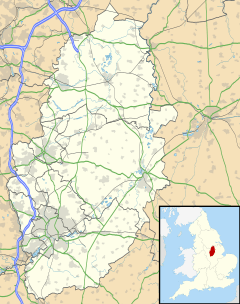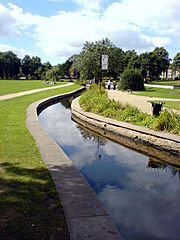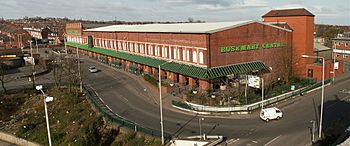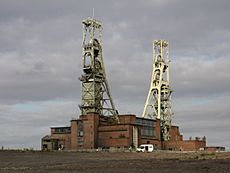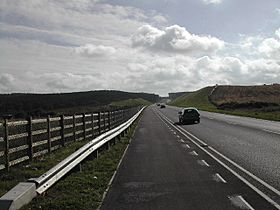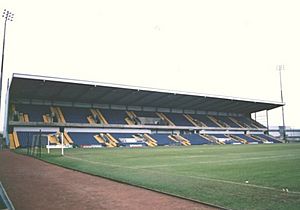Mansfield facts for kids
Quick facts for kids Mansfield |
|
|---|---|
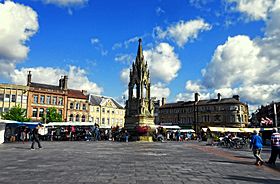 Mansfield Market Place with the Bentinck Memorial in the centre and the old Moot Hall behind to the left |
|
| Population | 106,556 |
| OS grid reference | SK 53745 61114 |
| District |
|
| Shire county | |
| Region | |
| Country | England |
| Sovereign state | United Kingdom |
| Post town | MANSFIELD |
| Postcode district | NG18, NG19 |
| Dialling code | 01623 |
| Police | Nottinghamshire |
| Fire | Nottinghamshire |
| Ambulance | East Midlands |
| EU Parliament | East Midlands |
| UK Parliament |
|
Mansfield is a market town and the administrative centre of Mansfield District in Nottinghamshire, England. It is the largest town in the wider Mansfield Urban Area (followed by Sutton-in-Ashfield). It gained the Royal Charter of a market town in 1227. The town lies in the Maun Valley, 12 miles (19 km) north of Nottingham and near Sutton-in-Ashfield. Most of the 106,556 population live in the town itself (including Mansfield Woodhouse), with Warsop as a secondary centre. Mansfield is the one local authority in Nottinghamshire with a publicly elected mayor.
Contents
History
Settlement in the Mansfield area is known to date back to Roman times, with a villa discovered in 1787 by a Major Rooke between Mansfield Woodhouse and Pleasley and a cache of denarii coins found near King's Mill in 1849. After the end of Roman occupation, the early English royalty are said to have stayed there, with the Mercian Kings having used it as a base for hunting in the nearby Sherwood Forest.
The Domesday Book compiled in 1086 has the settlement recorded as Mammesfeld whereas in later market-petition documents of 1227 the spelling had changed to Maunnesfeld. By the time of King Richard II signing a Warrant in November 1377 granting the right for the tenants to hold a fair every year for four days, the spelling had changed again to Mannesfeld.
There are remains of the 12th century King John's Palace, in Clipstone between Mansfield and Edwinstowe. The area was originally a retreat for royal families and dignitaries in the 14th and 15th centuries due to its location within Sherwood Forest famed for its fresh air and exclusiveness. Access to the town was via a small horse-drawn carriageway from the city of Nottingham that was en route to Sheffield.
On West Gate within the town centre, a commemorative wall plaque marks the point that was thought to be the centre of Sherwood Forest 2013. A tree has been planted nearby.
Access to the town between the 16th and 17th centuries was via several inns and stable yards. The Harte, the Swan (which has a dating stone with 1490 was found during alterations), the Talbot, the White Bear, the Ram (timber dating to pre 1500) and the White Lion were known to date from medieval times. Several timber-framed cruck buildings were demolished in 1929 and another in 1973 which was documented by a local historical society during its demolition and was dated at circa 1400, or earlier. Other Tudor houses on Stockwell Gate, Bridge Street and Lime Tree place were also demolished to make way for new developments before they could be viewed for being listed properties. The majority of buildings remaining are from the 17th century onwards.
Transport
Railway history
Mansfield railway station is on the Robin Hood Line, a link connecting with Nottingham and Worksop. From 1964 until 1995, Mansfield was by some definitions the largest town in Britain without a railway station, until the line was officially reopened by Secretary of State for Transport, Sir George Young. From 1973 to 1995 the nearby station at Alfreton was named "Alfreton and Mansfield Parkway", to encourage use as a railhead for Mansfield. A Sunday rail service was restored to Mansfield in December 2008.
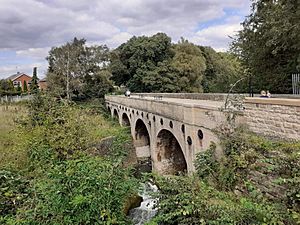
The town was originally the terminus of the Mansfield and Pinxton Railway, a horse-drawn plateway built in 1819 and one of the first acquisitions of the newly formed Midland Railway. The Midland used the final section to extend its new Leen Valley line to the present station in 1849.
The Midland Railway extended its Rolleston Junction–Southwell branch to Mansfield in 1871; continued the line north to Worksop in 1875; opened a link from Mansfield Woodhouse to Westhouses and Blackwell in 1886; and completed another link from Pleasley through Bolsover to Barrow Hill in 1890. The locally promoted Mansfield Railway between Kirkby South Junction and Clipstone Junctions—opened in stages between 1913 and 1916 for goods trains and in 1917 for Nottingham–Ollerton passenger trains, calling at a second Mansfield passenger station—broke the Midland Railway monopoly. Though nominally independent, the Mansfield Railway connected at both ends with the Great Central Railway, which worked the trains.
Mansfield had two railway stations: Mansfield Town, the former Midland station on Station Road; and Mansfield Central, the former Mansfield Railway station in Great Central Road, near Ratcliffe Gate. Central station lost its scheduled passenger services at the beginning of 1956 and Town station closed to passengers in 1964, leaving Mansfield without passenger trains until the Robin Hood line restored them in 1995.
Mansfield & District Light Railways ran a tram service between 1905 and 1932.
Today
Road
The M1 motorway lies west of Mansfield. It is 6.8 miles (10.9 km) from Junction 28 at Pinxton for traffic from the south, and an equal distance from Junction 29 at Heath, Derbyshire for traffic from the north and Chesterfield.
The A60 road runs north–south through Mansfield, between Nottingham and Worksop. The A617 road skirts around the town, providing a road link eastwards towards Newark-on-Trent as well as westwards towards Chesterfield and the M1.
Buses
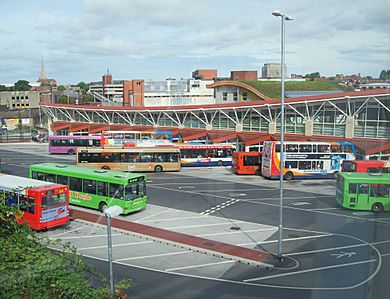
Buses in Mansfield are mainly operated by Stagecoach, with Trent Barton and National Express also working the area. The council granted planning permission for a new bus station on the former Station Road car park, expected to cost £7 million, in 2006. The old bus station, built in 1977, handled around 1,500 buses and 16,000 passenger arrivals a day; but had an outdated design and appearance, and poor outdoor waiting facilities.
There were good pedestrian links to the pedestrianised town-centre shopping streets; however, the railway station was several hundred yards away. The new bus station addressed the problem but proved unpopular with shopkeepers near the old facility, with several claiming marked reductions in trade.
The new bus station and transport interchange opened on 31 March 2013 in a location on a former car park close to the railway station. It is part of a regeneration scheme known as "Gateway To Mansfield", which aims to give visitors a clean and tidy first impression, including buildings with a themed use of local sandstone. The scheme also aims to improve facilities for locals, boost visitors to the town and help step up the local economy.
The new bus station increased passenger safety and provides a more welcoming scene for arriving visitors. Improvements have included an enclosed waiting area, automatic doors for fume reduction and safety, a tourist information centre, electronic bus and rail departure information, toilets, and baby-changing facilities. A tower with lift and stairs to an elevated walkway connects it to the railway station.
Parks
Mansfield has many parks and green spaces. Titchfield Park, located on the same site as the Water Meadows swimming complex, offers large grassy areas on both sides of the river Maun, crossed by two foot bridges. The park boasts a bowls green, hard tennis courts, basketball court, children's play area and many flowerbeds which are filled with blooms during the summer months.
Fisher Lane Park, located nearby stretching from the top of Littleworth through to Rock Hill, is a green space popular with dog walkers, kite flyers and skaters, since Mansfield District Council installed a concrete skate plaza, causing some controversy with locals.
However, the skate plaza has proven to be very popular with local youths, who access it daily. During the summer months, small fairs use Fisher Lane Park to set up some rides and stalls for local children.
Carr Bank Park is another park close to the town, which has a rocky 'grotto', bandstand and many flower beds, which are filled with blooms during the summer. The park has a new war memorial built of local sandstone dedicated to those who were killed in action since the end of the Second World War, to compliment the original setting unveiled after the First War in 1921.
Twin town and other associations
Mansfield has been officially twinned with Heiligenhaus in Germany since 1974
 Germany, Heiligenhaus
Germany, Heiligenhaus
The following entries can be seen in a Mansfield-based, self-published website:
 USA, Mansfield, Ohio
USA, Mansfield, Ohio USA, Mansfield, Massachusetts
USA, Mansfield, Massachusetts USA, Mansfield, Texas
USA, Mansfield, Texas Ireland, Mansfieldtown
Ireland, Mansfieldtown
Neighbouring cities, towns and villages
 |
Sheffield, Chesterfield, Bolsover, Glapwell, Pleasley | Worksop, Shirebrook, Warsop, Mansfield Woodhouse | Gainsborough, Retford, Ollerton, Clipstone, Edwinstowe |  |
| Matlock, Teversal, Skegby | Rainworth, Bilsthorpe, Lincoln | |||
| Sutton-in-Ashfield, Kirkby-in-Ashfield, Eastwood, Alfreton, Heanor, Ripley, Derby | Ravenshead, Newstead, Hucknall, Ilkeston, Nottingham | Blidworth, Southwell, Newark-on-Trent, Grantham |
Nottingham
Climate
Mansfield experiences a maritime climatic regime, as is typical for all parts of the British Isles. This results in a narrow temperature range, evenly spread rainfall, low levels of sunshine, and often breezy conditions throughout the year. The closest weather station to Mansfield for which records are available is Warsop, approximately 4 miles to the North of Mansfield town centre.
The absolute maximum temperature record for the area stands at 34.6c(94.3f), recorded in August 1990. In a typical year the warmest day should reach 28.9c(84.0f), and 12.72 days should reach 25.1c(77.2f) or higher.
The absolute minimum temperature record for the area is -19.1c(-2.4f), recorded during January 1987. 59.0 nights of the year report an air frost on average.
Rainfall averages 634mm annually, with 113 days reporting in excess of 1mm of rain. All averages refer to the observation period 1971-2000.
| Climate data for Warsop, elevation: 46m, 1981-2010, extremes 1960-2005 | |||||||||||||
|---|---|---|---|---|---|---|---|---|---|---|---|---|---|
| Month | Jan | Feb | Mar | Apr | May | Jun | Jul | Aug | Sep | Oct | Nov | Dec | Year |
| Record high °C (°F) | 14.4 (57.9) |
17.7 (63.9) |
22.2 (72.0) |
25.3 (77.5) |
27.0 (80.6) |
31.6 (88.9) |
32.5 (90.5) |
34.6 (94.3) |
27.9 (82.2) |
23.9 (75.0) |
18.0 (64.4) |
15.0 (59.0) |
34.6 (94.3) |
| Average high °C (°F) | 7.1 (44.8) |
7.5 (45.5) |
10.4 (50.7) |
12.7 (54.9) |
16.4 (61.5) |
19.1 (66.4) |
21.9 (71.4) |
21.5 (70.7) |
18.1 (64.6) |
13.9 (57.0) |
9.7 (49.5) |
7.3 (45.1) |
13.8 (56.8) |
| Daily mean °C (°F) | 3.9 (39.0) |
4.1 (39.4) |
6.4 (43.5) |
8.0 (46.4) |
11.2 (52.2) |
14.0 (57.2) |
16.4 (61.5) |
16.1 (61.0) |
13.4 (56.1) |
10.1 (50.2) |
6.4 (43.5) |
4.1 (39.4) |
9.5 (49.1) |
| Average low °C (°F) | 0.7 (33.3) |
0.7 (33.3) |
2.3 (36.1) |
3.3 (37.9) |
6.0 (42.8) |
8.8 (47.8) |
10.8 (51.4) |
10.6 (51.1) |
8.6 (47.5) |
6.2 (43.2) |
3.1 (37.6) |
0.9 (33.6) |
5.2 (41.4) |
| Record low °C (°F) | −19.1 (−2.4) |
−15.6 (3.9) |
−13.9 (7.0) |
−6.7 (19.9) |
−3.9 (25.0) |
−1.7 (28.9) |
1.4 (34.5) |
−0.1 (31.8) |
−3.2 (26.2) |
−6.6 (20.1) |
−8.4 (16.9) |
−15.2 (4.6) |
−19.1 (−2.4) |
| Average precipitation mm (inches) | 55.0 (2.17) |
38.9 (1.53) |
43.4 (1.71) |
55.6 (2.19) |
49.3 (1.94) |
68.8 (2.71) |
45.6 (1.80) |
52.5 (2.07) |
55.3 (2.18) |
61.9 (2.44) |
52.0 (2.05) |
58.9 (2.32) |
641.2 (25.24) |
| Average precipitation days | 11.0 | 8.3 | 10.0 | 9.6 | 8.8 | 9.2 | 7.9 | 8.4 | 8.7 | 10.2 | 10.2 | 10.5 | 112.7 |
| Source 1: KNMI | |||||||||||||
| Source 2: KNMI | |||||||||||||
Economy
Town centre
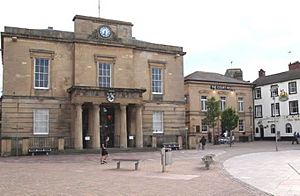
Mansfield has a large market place within its commercial and retail centre. The main market area was re-surfaced in 2005. In 2016 the council moved all market stalls from the old Buttercross Market in Westgate to join those sited in the main market area. Surroundings includes a museum, the Palace Theatre, restaurants, fast-food outlets, pubs, bars and night clubs.
On 6 April 2010 a town-centre Business Improvement District (BID) was founded with offices in the old Town Hall, financed by 2 per cent extra on the rateable value of nearby businesses.
The BID operates on a five-year basis, with a rolling yearly operational plan. Before its tenure ended in 2015, over 560 shops and other town-centre businesses were canvassed in late 2014 to vote on the first continuation period. Mansfield District Council contracted out of the procedure at a projected cost to council taxpayers of £8,000. On a 55 per cent turnout, 77 per cent voted to extend the BID for another five years.
The BID's additional services (beyond the council's baseline statutory services) and delivery of projects enhance the town's shopping centre. It offers events to attract visitors and raise awareness and security for the town centre, including banning orders and improved shop frontages.
Records show the first yearly income to have been £294,697, with an operating surplus of £151,610. One achievement in 2012–2013 was a crowd-funded town centre Wi-Fi internet installation costing £37,000, and completed by June 2013, using a network of AP nodes requiring registration for free use, and dedicated optional BID local information "App" for Android and iPhone available for download. The intentions were to encourage shoppers and visitors to linger in the town centre for longer, to offer internet access to small businesses, and to provide market traders with a means of accepting non-cash payments.
Other BID moves have been "gating off" alleyways blighted by anti-social behaviour, improving signage, and enhancing cleansing operations. Several shopkeepers complained in 2011 that the BID was "not doing enough to boost town trade." In 2012, Mansfield Constituency Labour Party criticised the BID for receiving almost a million pounds in its first three years, with little to show for it.
In 2015 Mansfield BID moved out of its offices in the old Town Hall to allow structural repairs, relocating nearby. A mandatory ballot, required every five years, occurred in late 2014, and again in late 2019, resulting in a decision to renew the organisation.
Retail
Among Mansfield's retail outlets is the Four Seasons shopping centre created in 1973–1976, with over 50 units occupied by national chains and phone shops. Primark nationally took over the former Littlewoods premises, closing the Mansfield store and its associated in-house business Index) in 2005. The Primark premises underwent a refit in 2017. Other stores and a coffee chain have traded in West Gate since 2011, along with existing similar cafés.
BHS closed in 2016 and Beales in 2020. Debenhams' closure, part of a national sequence due to the Arcadia Group's financial failure, was announced in late 2020, followed by Burtons, Topman and Topshop.
Rosemary Centre, built as a large weaving shed in 1907 by John Harwood Cash and converted to retail in 1984, is a pedestrianised area off the town centre with a covered streetside parade. Argos relocated in 2017 to new owner Sainsbury's store. There are also three outdoor retail parks, two with adjacent branded fast-food outlets.
Civic Centre
The headquarters of Mansfield District Council were relocated to a new-build occupying part of a former recreation ground at Chesterfield Road South from August 1986, bringing together workers from 12 offices across the district. The project took two years and over-ran the anticipated cost by £1 million, totalling £6.7 million, then the council's biggest spending scheme. it was opened in 1987 by Princess Anne. Catering facilities are run by outside contractors.
From 2012, surplus office space was rented to outside concerns. Working with Ashfield District Council to cut costs, the legal services of both authorities were combined in existing ADC offices at Kirkby in Ashfield. Their joint regeneration service began earlier. The council decided in 2014 to close the Civic Centre counter-payments facility.
Job Centre Plus, an agency within the Department for Work and Pensions, moved in 2018 from two town-centre venues to the re-modelled Civic Centre interior ground floor. The vacated offices were intended for redevelopment as housing and retail.
Mansfield Community Partnership was created at the Civic Centre as a centralised hub for law and order, with police, street wardens, housing and anti social behaviour officers in a dedicated town-centre unit.
In October 2021, the council announced a plan to create a new community hub at the old town hall in the town centre, intending to relocate staff together with other parties having vested interests in the present building and area. The project will be subject to a successful bid for funding from central government under the Levelling up scheme announced in 2021. The Civic Centre is proposed to be redeveloped.
In January 2022, the council announced an intention to purchase and redevelop the old Beale's town-centre store and to relocate all existing staff along with external partnerships and new participants, swelling the daily footfall which would bolster existing retail traders. Funding for the scheme, named Mansfield Connect, will be determined by a Levelling Up grant.
Former employment and industry
Wolverhampton & Dudley Breweries in October 1999 acquired Mansfield Brewery, once the United Kingdom's largest independent brewery, for £253 million. Production ceased in 2002, and the Mansfield range of ales moved to manufacturing facilities around the country; the site was later sold to Pubmaster Ltd, and from the 2020s is being redeveloped as housing.
Mansfield's old-established soft drink manufacturer, R. L. Jones, with brand names Sunecta and Mandora, was bought by Mansfield Brewery in 1977. A move to a modern factory in Bellamy Road in 1975 released land projected for a high-density housing development known as Layton Burroughs. Mansfield Brewery sold the business in 1988 for £21.5 million to the Scottish drinks company A. G. Barr plc, producer of Irn-Bru, Tizer, and Mandora. At the time the firm employed 400 people. Production ceased there in January 2011 when A. G. Barr moved production to other sites.
After demolition of the brewery production buildings in 2008, the site remained unsold, with various projected uses mooted. Used temporarily since February 2015 as a trailer park, Mansfield planning department refused further consent in October 2015. One local councillor suggested it could be turned into a town farm, but instead a rented housing development was completed by 2021.
The older ornate office building 'Chadburn House' initially housed an interactive learning centre from 2002. It closed in April 2015, and was turned into office space for businesses, including the local newspaper, and a micro brewery with a cafe and bar.
Many areas near the town still show signs of coal mining, the main industry for most of the 20th century. A violent episode in the UK miners' strike (1984–1985) occurred in Mansfield on May Day 1984. Most of the area's miners had voted against a strike, but the local union initially maintained that the strike was official to show solidarity with strikers in other areas. When the coal board granted an extra day of leave after the bank holiday, a group of working miners confronted union officials and violence broke out with striking miners. Mansfield later hosted a breakaway union, the Union of Democratic Mineworkers, which recruited many who had opposed the 1984–1985 strike.
The head stocks close to the village of Clipstone are an important local landmark and community groups are trying to preserve them as a reminder of the area's mining history. As demand for coal fell, Mansfield's pits wound down and miners had to find other work.
Mining subsidence causes problems for properties around Mansfield. A few streets in and around the town form long rows of terraced houses reminiscent of the affordable housing provided for mine workers in the prime of the industry. Many were demolished in 2012 in Pleasley Hill, Market Warsop and elsewhere. The Coal Authority is based in the town.
Regeneration
In 2019 the UK government set up the Towns Fund, which aimed to regenerate areas in need of regeneration. Mansfield was one of these places with the aim of receiving 25 million for its regeneration and development. This is to part with The Mansfield Townscape Heritage Project, which provided grants by the National Lottery to renovate parts of the town centre.
Several urban regeneration projects planned for Mansfield involved large-scale demolition, but the financial crisis of 2007–2008 and subsequent central-government funding cuts and escalating austerity measures deferred them. Mansfield District Council promoted two new developments: Arrival Square, opened 2008, an office block occupied by the Probation Service by the rail station; and Queen's Place—completed and opened by the mayor, Tony Egginton, in late 2013—which cost the council £2.4 million. It offered two new ground-floor retail units and six offices in Queen Street between the new transport interchange and the market square.
Reconstruction of the nearby King's Mill Hospital, part of which was completed by 2009, is near to the MARR road (Mansfield and Ashfield Regeneration Route) which opened in 2004, a bypass route around the town designed to reduce traffic through-flow and improve public access by connecting the A617 at Pleasley to the A617 at Rainworth.
In 2009 Mansfield made a bid for city status, appending redevelopment plans for retail, residential and leisure facilities with road improvements gradually being made; still pending as of August 2020.
Sport
Mansfield is home to Mansfield Town FC, known as the Stags or yellows. Relegated to the Conference National after 77 years in the Football League at the end of the 2007–2008 season, Mansfield Town returned to the Football League after winning the 2012–2013 Conference National title. Non-League club AFC Mansfield plays in the Forest Town area of Mansfield.
Mansfield Rugby Club is a rugby union club based at Eakring Road and currently plays in Midlands 1 East, a sixth-tier league in the English rugby union system. It won the Notts Cup for five years in succession and for a record 18 times.
Mansfield Giants is Mansfield's Premier Basketball Club, and has a three-star Accreditation and Club Mark from the English Sports Council. The team plays in the England Basketball (EB2).
The annual half marathon held for more than 30 years was cancelled after 2011 due to escalating costs, after changes to Health and Safety legislation meant professional services were needed to address road-closure measures, instead of volunteers. Mansfield local business networking group 2020 had hoped to restore a race by September 2014, but this event, reduced in length to 10 kilometres, was postponed, initially until spring 2015, and took place in August.
Angling is well supported in the Mansfield district, where ponds remain from the former textile milling industry.
Tennis is catered for by Mansfield Lawn Tennis Club located at the same site since 1883, with two grass courts and four asphalt courts, three of them floodlit. Further hard-surface courts are found in the district at six Mansfield District Council park locations.
Mansfield is home to Mansfield Roller Derby, Mansfield's premier Flat Track Roller Derby league.
One issue for local residents is Mansfield's lack of a central Leisure Centre. Mansfield District Council decided it would rubber stamp the sale of the existing Leisure Centre and extensive public car park to Tesco, which opened a large Tesco Extra store in 2007. The Council asserted that this would be replaced by a brand new Leisure Centre, but nothing has been built or is planned. It received over £5m from Tesco for the Leisure Centre site, but decided to spend this on refurbishing Sherwood Baths instead.
Mansfield has two indoor swimming centres and a third, smaller pool attached to a school, which has been under threat of closure since 2011. These facilities give Mansfield the largest square meterage of indoor water-sports facilities per capita of any town in the United Kingdom with less than 100,000 inhabitants.
Mansfield is one of three outlets for the Nottinghamshire County Council Swim Squad, which competes as Nova Centurion. The Sherwood Swimming Baths adjacent to the former Sherwood Colliery was refurbished and opened in January 2010 as the Rebecca Adlington Swimming Centre. The 25-metre pool was widened at the expense of losing tiered public seating and has a new, small, endless stroke-improvement training pool with variable-resistance water flow. The complex reduces its carbon footprint by using a ground-source heat pump backed by a biomass boiler burning wood pellets prepared from waste by a local wood yard.
At the Beijing 2008 Olympic Games, a Mansfield contestant, Rebecca Adlington, won two gold medals, for 400 and 800-metre freestyle swimming. After her record-breaking success, Adlington was welcomed home to Mansfield by thousands lining the streets to applaud as she passed in an open top bus. This culminated in an appearance at the old Town Hall in the Market Square. Her success boosted swimming interest in the area, leading to expansion of swimming classes to encourage young people to begin swimming. At the 2012 Olympic Games in and around London, Adlington won two Bronze medals again for 400 and 800 metres, the best performance of a generally disappointing Team GB swimming squad. She retired from competitive swimming in February 2012.
Water Meadows swimming complex opened during the Christmas holidays of 1990 in Bath Street, on the site of the former Mansfield Baths and defunct cattle market. It has a gym and a soft-play area for children with an adjoining café, as well as one 25-metre competition pool, two other pools, and a small teaching pool. The leisure lagoon pool has an artificial wave machine operating periodically, and also a slide and a shallow area like a beach. The complex is popular with family groups, and many surrounding schools make use of its facilities.
Mansfield Bowling Club is reputed to have origins in the 1700s. The club played at a bowling green to the rear of the Bowl in Hand pub in the town centre, until relocating into the grounds of Queen Elizabeth's Academy, with a new facility including pavilion opening in 2009.
Notable people
People with Wikipedia pages, in alphabetical order:
- Rebecca Adlington OBE (born 1989), Olympic bronze and gold medallist swimmer
- Richard Bacon (born 1975), broadcaster
- John Balance (1962–2004), singer/musician with Coil
- Ben Brown, lawyer and Crown Counsel to the British Overseas Territory of Saint Helena, Ascension and Tristan da Cunha
- James Collinson, Victorian painter
- Kris Commons (born 1983), Celtic F.C. footballer
- Nicholas Crafts (born 1949), economic historian
- Stephen Critchlow, radio, TV and stage actor
- Ed Davey, British politician, Leader of the Liberal Democrats since 2019
- Craig Disley (born 1981), Grimsby Town F.C. footballer
- Robert Dodsley (1704–1767), playwright and poet, wrote The King and The Miller of Mansfield and Sir John Cockle, performed at Drury Lane in 1736 and 1737 respectively
- Wes Dolan (born 1980), actor and singer/songwriter
- Suzanne Eggins, a linguist in Australia
- Watson Fothergill (1841–1928), Victorian architect
- Elspeth Gibson (born 1963), Nottingham-born fashion designer, studied at Mansfield College of Art and Design.
- Harry Harpham (1954–2016), coal miner and MP for Sheffield Brightside and Hillsborough
- Mark Holmes, lead singer of Canadian new wave rock group Platinum Blonde, born in Mansfield.
- Sir Richard Jebb, 1st Baronet (1729–1787), physician to the Royal Family
- Rob Kozluk (born 1977), footballer
- Ric Lee (born 1945), drummer with Ten Years After
- Sir Richard Leese (born 1951), local politician in Manchester
- Leo Lyons (born 1943), bassist, songwriter, producer with Ten Years After
- Alexander Malcolm former member of parliament in New Zealand
- Charles James Martin, Artist
- William Martin (1767–1810), naturalist, born in Mansfield 1767.
- John Ogdon (1937–1989), pianist, born in Mansfield Woodhouse
- Greg Owen (born 1972), professional golfer
- Joel Peat, lead guitarist of the band Lawson
- James Perch (born 1985), Mansfield Town footballer
- Tom Scott (born 1984), YouTuber and former TV presenter
- Sir Charles Seely, 2nd Baronet British Industrialist
- Alvin Stardust (1942–2014), pop singer
- Steve Ward (born 1957) accoladed as oldest active professional boxer
- John Bainbridge Webster (1955–2016), Professor of Divinity at St Mary's College, University of St Andrews.
- John Whetton (born 1941), track runner
- Helen Mary Wilson (physician), a physician and social purity campaigner
- Oliver Wilson (born 1980), professional golfer
Images for kids
See also
 In Spanish: Mansfield para niños
In Spanish: Mansfield para niños


